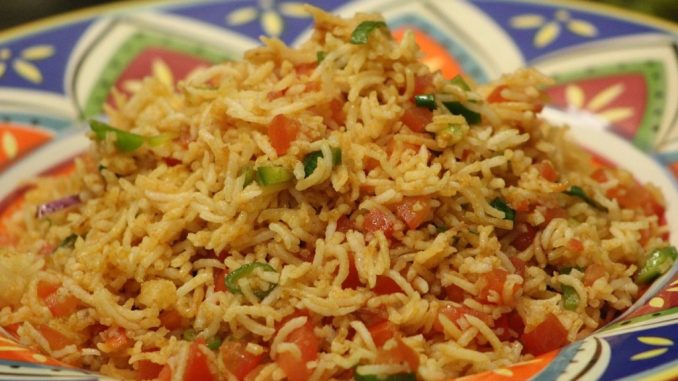
Image by Isnt_optional from Pixabay
What do you think of when you hear about Mexican food? Surely, you think of tacos, enchiladas, tamales, gorditas, nachos, or guacamole. All of them are undoubtedly delicious. However, did you know that Mexico has many other typical dishes? One of them is rice with tomato, also called “red” rice or, as it is internationally known, Mexican rice. If you want to know a little more about this Mexican dish, keep reading.
When Asian rice met Mexican tomato
Rice (Oryza sativa, as botanists call it) is the most produced and consumed cereal in the world. Nearly half of the human population around the globe depends on rice to meet their basic food needs. This is true mainly in East and Southeast Asia, but rice has also become part of the daily diet of people on other continents.
From its beginnings by the banks of the Indus River five thousand years ago, rice cultivation spread first eastward to the eastern Pacific territories, and then, from the 16th century, westward to Europe and its colonies. It seems that the Portuguese were the first Europeans to attempt rice cultivation in the 18th century.
During the 19th century, rice reached the Americas. Its cultivation was so successful that by the 20th century it had become part of the cuisines of several countries from Mexico to South America.
From the union of Asian rice and tomato, native to Mexico, an original dish was born—Mexican rice. As you may already know, Mexican rice has a characteristic reddish color. It is due to tomato paste that is added to rice when cooking.
If you already love Mexican food, you will certainly love Mexican rice, and want to know how to cook it. To get a delicious result, you only have to follow this best Mexican rice recipe.
The basic ingredient of Mexican rice, of course, is steamed white rice. However, you should know that in Spanish-speaking countries, particularly in Mexico, the most common way of cooking rice for different dishes requires sautéing the seasoning.
Preparing rice with sautéed seasoning is very easy. Just follow these steps:
- Finely chop a little
- Take a saucepan, put it on the stove and turn on the heat.
- Pour into the pan a tablespoon of corn oil and a tablespoon of onion already cut. If you really like the flavor of onion, you can add one more tablespoon.
- Sauté the chopped onion for a few minutes, just enough to brown it slightly.
At this point, if you want to get simple steamed white rice, continue as follows:
- Pour one cup of rice and two cups of water over the sautéed onion.
- Add two pinches of salt.
- Let the mixture boil.
- Reduce heat when water begins to boil.
- Let simmer for about 20 minutes.
To cook rice more evenly, you should put on the pan lid while rice is simmering.
If you add one or two spoonfuls of tomato paste and mix them with the cooking rice before the water begins to boil, you will get “red” rice. Tomato paste can be purchased ready-made in markets.
You can sauté a spoonful of diced fresh tomato with the chopped onion. This will contribute to give good flavor to your rice, but it is not enough to dye it red.
If you want a spicy touch, you can sauté a spoonful of chopped chili pepper with the chopped onion. Do not forget to remove seeds first.
Instead of plain water, it is customary to cook Mexican rice with broth. It is very common to use chicken broth. The two cups of water mentioned above can be substituted with two cups of chicken broth. It can be just one cup, although the result will not be as tasty. In any case, the important thing is that the amount of liquid, in general, should always be twice as the amount of rice.
Contrary to Asian tastes, in Mexico and in other Latin American countries loose rice is preferred to sticky or lumpy rice. This can be achieved in two ways. One way is to wash rice well before cooking.
To wash rice, follow this simple procedure:
- Pour a cup of rice into a colander large enough so that the amount of rice does not overflow.
- Place the colander filled with rice under running water.
- As water runs over the rice, gently stir the grains with the help of a spoon. You can also use your own hand by putting your fingers together like a spatula. You will see that the water draining from the colander has a whitish color. This is due to the excess starch coating the grains.
- Keep washing and stirring until the water draining from the colander is no longer whitish.
Do not store wet rice. You should cook it soon so that mold would not grow on rice grains.
Without excess starch, rice grains will not stick together or form lumps if cooked properly.
If you prefer not to wash your rice, you can do this simple trick:
- Once your rice is cooked, turn off the heat and let it cool for a few minutes.
- Then, stir it with a large fork with long tines.
- Do this several times until you see that all or almost all the grains have separated.
However, to achieve the desired result more surely, wash the rice before cooking it, and stir with a fork when it is already cooked.




